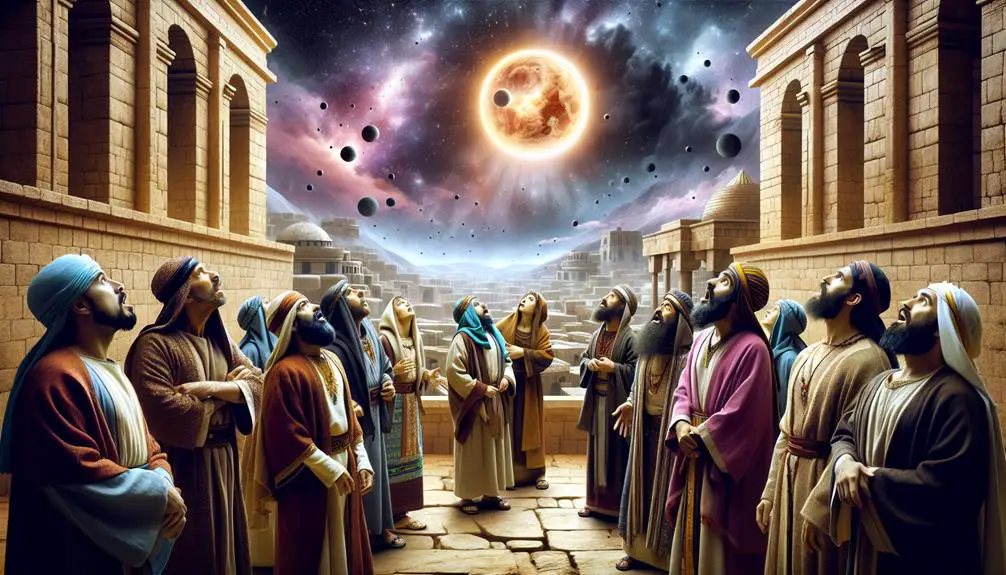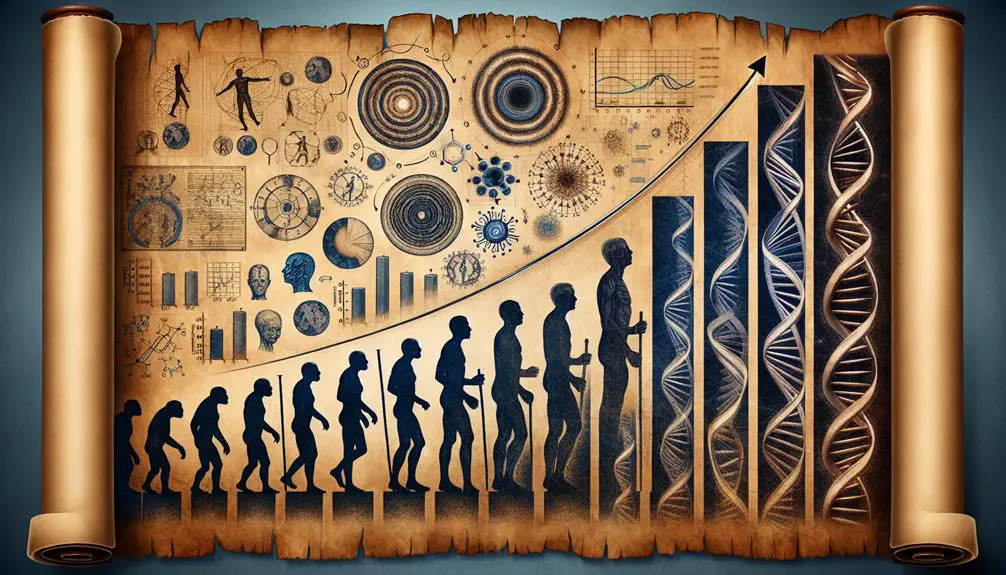Uncover the intriguing blend of science and scripture, where modern discoveries challenge ancient biblical narratives.

Scientific Mistakes in the Bible
Exploring the Bible through the lens of modern science unveils a fascinating intersection between faith and empirical evidence. Subjects like the creation timeline, the shape of the Earth, and the account of the great flood, among others, provide rich ground for discussion.
While some view these descriptions as literal truths, others interpret them metaphorically, arguing that the ancients communicated in the language and understanding of their time. This raises intriguing questions about the nature of religious texts and their place in a scientifically informed world.
Join us as we navigate these complex waters, where faith and science meet.
Key Takeaways
- The Bible's six-day creation narrative contrasts with scientific evidence of a universe billions of years old.
- Biblical cosmology's flat Earth and firmament concept is debunked by modern understanding of Earth as an oblate spheroid.
- Interpretations of Pi in the Bible show inaccuracies when compared to the mathematically established value.
- The classification of bats as birds in the Bible contrasts with their scientific classification as mammals.
The Creation Timeline

The creation narrative in the Bible, particularly the account in Genesis, presents a timeline that has been a subject of extensive debate and analysis, especially when juxtaposed with established scientific understandings of the universe's origins. The biblical account suggests a universe brought into existence over a period of six days—a perspective that diverges significantly from the billions of years outlined by cosmological and geological evidence. This discrepancy raises questions about the compatibility of scriptural interpretations with empirical scientific evidence.
From a scientific standpoint, the evidence supporting evolution and the gradual development of life on Earth is overwhelming. Fossil records, geological data, and, more recently, genetic diversity studies offer a cohesive narrative of life's origins and transformations over approximately 3.8 billion years. Genetic diversity, in particular, provides compelling evidence of common ancestry among all living organisms, a concept that is incongruent with the sudden appearance of fully formed species as outlined in Genesis.
Furthermore, the concept of evolution is not merely based on physical evidence but is also supported by observable processes, such as natural selection and genetic mutations which contribute to the genetic diversity seen in populations today. These mechanisms, documented and analyzed over centuries, illustrate a natural progression of life that contrasts sharply with the instantaneous creation model.
In considering both the biblical narrative and scientific evidence, it is crucial to approach the topic with a nuanced understanding that respects both religious beliefs and scientific inquiry. While the Genesis account offers spiritual and philosophical insights into the origins of life and the universe, evolution evidence and the study of genetic diversity provide a robust framework for understanding the biological complexities of our world.
The Shape of the Earth

The biblical depiction of the Earth's shape has been a topic of considerable debate and analysis, particularly in the context of scientific accuracy. An examination of Biblical cosmology provides insight into ancient perceptions, which contrast markedly with contemporary understandings of our planet's form.
This section will critically assess these viewpoints, considering modern interpretations and the implications for reconciling faith with empirical evidence.
Biblical Cosmology Overview
Biblical cosmology, particularly concerning the Earth's shape, has been a subject of extensive debate and interpretation among scholars and theologians. Central to this discourse is how ancient texts describe the universe's structure, focusing on elements like the heavenly firmament and celestial bodies. Key points in these discussions include:
- The depiction of the Earth as a flat entity supported by pillars or foundations.
- The concept of the heavenly firmament, a solid dome separating the 'waters above' from the 'waters below.'
- The placement and role of celestial bodies within this firmament, serving specific functions such as marking time.
- Interpretations of these descriptions, varying between literal historical accounts and metaphorical, theological expressions.
This complex blend of imagery and symbolism in biblical cosmology offers rich ground for analysis, highlighting the intersection of ancient religious beliefs and emerging scientific understanding.
Earth's Form Critique
Having explored the overarching themes of biblical cosmology and its depiction of the universe's structure, attention now turns to critically examining the ancient text's portrayal of Earth's shape.
The Bible's description, often interpreted as presenting the Earth as a flat expanse, seems at odds with modern scientific understanding. Through ocean depths exploration and atmospheric layers analysis, contemporary science reveals the Earth as an oblate spheroid. Such empirical evidence stands in stark contrast to any flat Earth interpretation.
However, it's crucial to analyze these ancient descriptions with an understanding of the historical and cultural context in which they were written. The biblical portrayal was not intended as a scientific assertion but rather a reflection of the understanding and observations of the time.
Modern Interpretations Revisited
In recent years, scholarly efforts have increasingly focused on reevaluating the interpretation of Earth's shape as depicted in ancient texts, including the Bible, in light of contemporary scientific insights. This reexamination has led to a nuanced understanding, considering:
- Cultural Influences: How ancient cosmologies shaped the biblical authors' conception of the Earth.
- Translation Errors: Misinterpretations arising from translating ancient languages to modern tongues.
- Literary Context: Recognizing poetic and metaphorical language that may not intend to describe physical realities.
- Historical Knowledge: Understanding the level of scientific knowledge available at the time of writing.
This analytical approach promotes a balanced view, acknowledging the Bible's historical and spiritual context while recognizing the evolution of scientific understanding about the Earth's shape.
The Value of Pi

The interpretation of the value of Pi, as described in biblical texts, has sparked a considerable debate surrounding its mathematical accuracy and the implications for biblical inerrancy.
Critics argue that the biblical representation of Pi is inaccurate, while others contend that contextual and historical perspectives must be taken into account.
This discussion necessitates a balanced examination of the mathematical, historical, and theological dimensions to understand the nuances of this debate.
Biblical Pi Interpretation
A common point of contention among scholars and readers alike is the interpretation of the biblical value of Pi as described in the book of Kings. This discourse often touches upon:
- Ancient Numerology: How numerological interpretations could have influenced biblical texts.
- Geometry Origins: The understanding of geometric concepts at the time the biblical texts were written.
- Cultural Context: The role cultural perceptions played in shaping mathematical descriptions.
- Translation Variability: How translations over centuries might have altered the precise mathematical descriptions.
This analysis strives to remain balanced, acknowledging the complex interplay between ancient numerology, the origins of geometry, cultural influences, and translation challenges. It's crucial to understand that interpretations of ancient texts often reflect the knowledge and biases of both their original authors and contemporary interpreters, thus necessitating a careful, nuanced approach to their analysis.
Mathematical Accuracy Debate
Debates surrounding the mathematical accuracy of the value of Pi as referenced in biblical texts have long sparked scholarly discussions, reflecting a complex interplay between ancient mathematics and scriptural interpretation. Critics often point to a perceived discrepancy in the Bible's portrayal of Pi, arguing it demonstrates a fundamental misunderstanding of mathematical principles. However, proponents counter that this interpretation neglects the importance of number symbolism and geometric metaphors prevalent in ancient texts.
They suggest that the biblical reference was never intended to serve as a precise mathematical statement but rather as a symbolic expression, fitting within the literary and theological aims of the scripture. This debate highlights the challenges in applying modern scientific standards to ancient religious documents, requiring a nuanced understanding of historical context, literary genres, and the symbolic language of numbers.
Historical Context Considerations
Understanding the historical context of the biblical reference to the value of Pi is essential to appreciate the nuances of ancient mathematical expression and its symbolic significance. This recognition allows for a more informed analysis:
- Cultural Translations: Interpretations of ancient texts undergo various cultural translations, impacting the precision of mathematical descriptions.
- Archaeological Evidence: Artefacts and inscriptions provide insights into the mathematical understanding of ancient civilizations, including their approximation of Pi.
- Symbolic Significance: Numerical values in sacred texts often carry symbolic rather than literal meanings, reflecting the spiritual or moral lessons intended by the authors.
- Mathematical Expression: The ancients had different standards for mathematical accuracy, focusing more on practical applicability than on theoretical precision.
A balanced, analytical approach considers these aspects to understand the historical and cultural context behind biblical references.
The Great Flood

The narrative of the Great Flood, as depicted in the Bible, raises significant questions regarding its scientific plausibility and historical accuracy. This story, foundational to many cultures and religions, describes a deluge engulfing the earth to cleanse it of humanity's wickedness, sparing only Noah, his family, and representatives of all animal species. Critically examining this account through a scientific lens, especially focusing on the aspects of animal survival and geographical evidence, reveals several challenges.
Firstly, the survival of all animal species in a single ark poses logistical and biological dilemmas. The sheer biodiversity requires an ark of implausible dimensions and an ecosystem capable of supporting varied dietary and habitat needs. Additionally, the genetic bottleneck effect, resulting from a limited number of individuals of each species, would lead to severe inbreeding and genetic drift, likely causing many species to become extinct soon after the flood.
Geographical evidence further complicates the narrative. For a flood to cover the highest mountains, as described, would require water volumes exceeding Earth's known reserves, including all oceans, ice caps, and atmospheric vapor. Moreover, such an event would leave identifiable sedimentary layers worldwide, yet geological records do not support a global flood in recent history. Sedimentary layers show local flooding events but nothing of the magnitude or synchronicity the biblical account suggests.
While the story of the Great Flood carries profound cultural and moral significance, its scientific examination presents substantial challenges. These include the feasibility of animal survival aboard the ark and the lack of consistent geographical evidence supporting a global deluge.
The Sun Stands Still

Another biblical account that has sparked scientific scrutiny involves Joshua's request for the sun to stand still in the sky, an event described in the Book of Joshua. This narrative, under Joshua's leadership, is often cited as one of the most perplexing astronomical anomalies in religious texts. From a scientific perspective, the event raises significant questions regarding its feasibility and the understanding of cosmology at the time.
The account, traditionally interpreted, suggests a suspension of Earth's rotation or a miraculous extension of daylight hours, both of which present considerable challenges when analyzed through the lens of modern astronomy and physics. Here are several points of interest:
- Physical Impossibility: The halt of Earth's rotation, necessary for the sun to 'stand still,' would require a cessation of the planet's angular momentum. The immediate stop would have catastrophic global consequences, none of which are recorded.
- Astronomical Perspective: No known natural mechanism could cause such an event without disrupting the solar system's stability. Historical records from other civilizations of the time do not report any comparable astronomical anomalies.
- Interpretation Variability: Some scholars suggest metaphorical or poetic interpretations, viewing the event as an expression of divine intervention under Joshua's leadership rather than a literal astronomical phenomenon.
- Historical Context: This account may reflect the authors' attempts to convey the miraculous nature of Joshua's victories, emphasizing divine support rather than providing an accurate description of natural events.
Human Lifespans

Exploring the topic of human lifespans, biblical narratives present ages that far exceed modern expectations and scientific understanding of human longevity. Characters like Methuselah, who purportedly lived to the age of 969 years, challenge contemporary scientific knowledge about the limits of human life. From a scientific perspective, these extraordinary lifespans are implausible given what is known about human biology, genetics, and the historical environment.
One scientific concept that contradicts these biblical ages is the genetic bottleneck. This principle suggests that significant reductions in a population's size can lead to decreased genetic variation, impacting the health and longevity of future generations. The biblical accounts of human lifespans occurring before and after major events like the Flood could be interpreted through this lens, suggesting that such long lifespans are unlikely to have occurred if a genetic bottleneck had taken place.
Additionally, there is curiosity around the notion of 'Methuselah's diet' or the idea that dietary or environmental conditions at the time could have contributed to these extended lifespans. However, no scientific evidence supports the existence of a diet or lifestyle that could increase human lifespan to the extents described in the Bible. Modern nutrition and medical science have made significant strides in understanding what contributes to healthy aging, yet nothing suggests the possibility of reaching the near-millennial ages noted in these texts.
Bats as Birds

In the biblical classification of animals, bats are notably categorized alongside birds, a grouping that diverges significantly from modern scientific understanding. This classification can be found within the Levitical laws, which include various instructions on what is clean and unclean for consumption. From a contemporary perspective, this amalgamation of bats with birds underlines a fundamental misunderstanding of animal classification, as bats are mammals, not birds. Analyzing this discrepancy offers a fascinating glimpse into the historical context of knowledge and how it has evolved over time.
To understand the significance of this classification, consider the following points:
- Levitical Context: The Levitical laws were integral to the daily lives and spiritual practices of ancient Israelites. These laws, including those about clean and unclean animals, played a crucial role in maintaining ritual purity.
- Historical Classification: In ancient times, animals were often classified by observable characteristics. Since bats fly much like birds, it is understandable, though scientifically inaccurate, that they were grouped together.
- Modern Taxonomy: Modern science classifies animals based on a wide range of criteria, including genetic makeup, which clearly distinguishes bats from birds. Bats are classified as mammals primarily because they give birth to live young and nurse them with milk.
- Cultural and Religious Interpretation: The biblical categorization of bats with birds reflects the understanding and cultural context of the time. It highlights the evolution of knowledge from a pre-scientific era to today's highly detailed system of taxonomy.
This analysis shows that while the biblical classification of bats as birds diverges from current scientific understanding, it also offers insight into the historical and cultural context of ancient knowledge systems.
Frequently Asked Questions
How Does the Bible's Description of the Firmament Compare With Modern Astronomical Findings?
The Bible's depiction of the firmament, historically interpreted as a solid dome separating 'waters above' from 'waters below,' contrasts with contemporary astronomical understanding. Modern science elucidates the Earth's atmosphere as composed of various layers without a solid barrier, and outer space extends beyond without a definitive boundary, where starlight speed is a fundamental measure.
This comparison highlights a significant divergence between ancient textual interpretations and current findings in atmospheric and astronomical sciences.
What Does the Bible Say About Dinosaurs, and How Does It Align or Conflict With Scientific Evidence of Their Existence?
The Bible's mentions of creatures like Behemoth and Leviathan have sparked interpretations suggesting references to dinosaurs, juxtaposing ancient texts with paleontological evidence.
While some view these descriptions as metaphorical or symbolic, others see them as literal accounts, pitting traditional religious narratives against scientific discoveries.
This analysis examines the alignment or conflict between biblical accounts and scientific evidence regarding dinosaurs, balancing theological interpretation and paleontological findings in a nuanced discussion.
In What Ways Does the Bible's Account of Human Origin Differ From the Theory of Evolution, and What Are the Implications of These Differences?
The Bible's account of human origin, emphasizing a singular creation event, contrasts with the theory of evolution, which posits gradual development and genetic diversity over millions of years.
This divergence influences the interpretation of cultural narratives surrounding human existence. The implications of these differences extend to discussions on the validity and integration of religious beliefs with scientific understanding, challenging the reconciliation of historical religious texts with contemporary scientific discoveries.
How Do Biblical References to Leprosy and Other Diseases Reflect the Understanding of Medical Science at the Time, and How Do They Compare With Current Medical Knowledge?
Biblical references to leprosy serve as a historical lens, magnifying ancient perceptions of disease and medical practice. These texts reflect a rudimentary understanding, particularly highlighting the leprosy stigma and quarantine practices of the time.
When juxtaposed with contemporary medical knowledge, the gap widens, showcasing advancements in diagnosing and treating diseases that were once shrouded in myth and fear. This comparison underscores a journey from shadowed misconceptions to enlightened, evidence-based medicine.
Does the Bible Make Any Reference to the Concept of a Multiverse or Parallel Universes, and How Does This Idea Fit Within Both Ancient and Contemporary Cosmological Theories?
The inquiry into whether the Bible references concepts akin to a multiverse or parallel universes necessitates an examination through both ancient theological interpretations and contemporary cosmological theories, including quantum theories.
While the Bible does not explicitly mention these modern scientific concepts, interpretations of its texts can vary widely. Bridging these ancient texts with current quantum theories offers a fascinating, though complex, dialogue between science and spirituality, inviting a nuanced exploration of cosmology across epochs.
Conclusion
In conclusion, the examination of scientific inaccuracies within the Bible reveals the interplay between religious texts and scientific understanding. Examples such as the creation timeline, the depiction of the Earth's shape, the value of Pi, the narrative of the Great Flood, the account of the sun standing still, the portrayal of human lifespans, and the classification of bats as birds underscore this relationship.
A fascinating statistic shows that 33% of scientists believe in a personal god, indicating a complex relationship between faith and scientific inquiry. This analysis not only highlights discrepancies but also invites reflection on the evolving nature of knowledge and belief systems.



Sign up